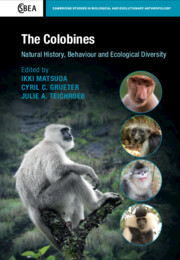Book contents
- The Colobines
- Cambridge Studies in Biological and Evolutionary Anthropology
- The Colobines
- Copyright page
- Contents
- Contributors
- Foreword
- Acknowledgements
- 1 General Introduction
- 2 Taxonomic Classification of Colobine Monkeys
- 3 The Colobine Fossil Record
- 4 Molecular Phylogeny and Phylogeography of Colobines
- 5 Relationships between the Diet and Dentition of Asian Leaf Monkeys
- 6 Morphology and Physiology of Colobine Digestive Tracts
- 7 Colobine Gut Microbiota
- 8 Colobine Nutritional Ecology
- 9 Red Colobus Natural History
- 10 Natural History of Black-and-White Colobus Monkeys
- 11 Behaviour and Ecology of Olive Colobus
- 12 Ecology and Behaviour of Odd-Nosed Colobines
- 13 Ecology of Semnopithecus
- 14 Ecology of Sympatric and Allopatric Presbytis and Trachypithecus Langurs in Sundaland
- 15 Ecology of Trachypithecus spp. in the Indo-Burmese Region
- 16 Socioecology of Asian Colobines
- 17 Socioecology of African Colobines
- 18 Causes and Consequences of the Formation of Multilevel Societies in Colobines
- 19 Colobine Population Ecology
- 20 State of Asian Colobines and Their Conservation Needs
- 21 Conservation of Africa’s Colobine Monkeys (Cercopithecidae, Colobinae) with Taxonomic and Biogeographic Considerations
- 22 Directions for Future Research
- References
- Index
- References
References
Published online by Cambridge University Press: 08 February 2022
- The Colobines
- Cambridge Studies in Biological and Evolutionary Anthropology
- The Colobines
- Copyright page
- Contents
- Contributors
- Foreword
- Acknowledgements
- 1 General Introduction
- 2 Taxonomic Classification of Colobine Monkeys
- 3 The Colobine Fossil Record
- 4 Molecular Phylogeny and Phylogeography of Colobines
- 5 Relationships between the Diet and Dentition of Asian Leaf Monkeys
- 6 Morphology and Physiology of Colobine Digestive Tracts
- 7 Colobine Gut Microbiota
- 8 Colobine Nutritional Ecology
- 9 Red Colobus Natural History
- 10 Natural History of Black-and-White Colobus Monkeys
- 11 Behaviour and Ecology of Olive Colobus
- 12 Ecology and Behaviour of Odd-Nosed Colobines
- 13 Ecology of Semnopithecus
- 14 Ecology of Sympatric and Allopatric Presbytis and Trachypithecus Langurs in Sundaland
- 15 Ecology of Trachypithecus spp. in the Indo-Burmese Region
- 16 Socioecology of Asian Colobines
- 17 Socioecology of African Colobines
- 18 Causes and Consequences of the Formation of Multilevel Societies in Colobines
- 19 Colobine Population Ecology
- 20 State of Asian Colobines and Their Conservation Needs
- 21 Conservation of Africa’s Colobine Monkeys (Cercopithecidae, Colobinae) with Taxonomic and Biogeographic Considerations
- 22 Directions for Future Research
- References
- Index
- References
Summary

- Type
- Chapter
- Information
- The ColobinesNatural History, Behaviour and Ecological Diversity, pp. 399 - 496Publisher: Cambridge University PressPrint publication year: 2022



